The Unification Epicenter of True Lightworkers
Lost Cave City in the Grand Canyon?

Did an ancient civilization live in caves below the Grand Canyon? This is as vague a statement as wondering why some of the ancient Mesoamerican people depicted their gods as white men or the Olmec gods looked African. Stretching the imagination ... perhaps whatever was found in the Grand Canyon caves discussed below, is linked to Ancient Alien Theory. It is interesting to speculate on ancient Egyptians or Tibetans flying to the Grand Canyon in Vimanas, but, to date, there is no tangible proof to support these claims.
Archeological Coverups
Perhaps the most amazing suppression of all is the excavation of an Egyptian tomb by the Smithsonian itself in Arizona. A lengthy front page story of the Phoenix Gazette on April 5, 1909, gave a highly detailed report of the discovery and excavation of a rock-cut vault by an expedition led by a Professor S.A. Jordan of the Smithsonian. The Smithsonian, however, claims to have absolutely no knowledge of the discovery or its discoverers.

The World Explorers Club decided to check on this story by calling the Smithsonian in Washington, D.C., though we felt there was little chance of getting any real information. After speaking briefly to an operator, we were transferred to a Smithsonian staff archaeologist, and a woman's voice came on the phone and identified herself. I told her that I was investigating a story from a 1909 Phoenix newspaper article about the Smithsonian Institution's having excavated rock-cut vaults in the Grand Canyon where Egyptian artifacts had been discovered, and whether the Smithsonian Institution could give me any more information on the subject.
She said, "The first thing I can tell you, before we go any further, is that no Egyptian artifacts of any kind have ever been found in North or South America. Therefore, I can tell you that the Smithsonian Institute has never been involved in any such excavations."
She was quite helpful and polite but, in the end, knew nothing. Neither she nor anyone else with whom I spoke could find any record of the discovery or either G.E. Kinkaid and Professor S.A. Jordan. While it cannot be discounted that the entire story is an elaborate newspaper hoax, the fact that it was on the front page, named the prestigious Smithsonian Institution, and gave a highly detailed story that went on for several pages, lends a great deal to its credibility.
It is hard to believe such a story could have come out of thin air. If this story is true it would radically change the current view that there was no transoceanic contact in pre-Columbian times, and that all American Indians, on both continents, are descended from Ice Age explorers who came across the Bering Strait.
Is the idea that ancient Egyptians came to the Arizona area in the ancient past so objectionable and preposterous that it must be covered up? Perhaps the Smithsonian Institution is more interested in maintaining the status quo than rocking the boat with astonishing new discoveries that overturn previously accepted academic teachings. Historian and linguist Carl Hart, editor of Word Explorer, then obtained a hiker's map of the Grand Canyon from a bookstore in Chicago.
Poring over the map, we were amazed to see that much of the area on the north side of the canyon has Egyptian names. The area around Ninety-four Mile Creek and Trinity Creek had areas (rock formations, apparently) with names like Tower of Set, Tower of Ra, Horus Temple, Osiris Temple, and Isis Temple.
The Isis Temple
The Tower of Set
The Tower of Ra
In the Haunted Canyon area were such names as the Cheops Pyramid, the Buddha Cloister, Buddha Temple, Manu Temple and Shiva Temple. Was there any relationship between these places and the alleged Egyptian discoveries in the Grand Canyon?
We called a state archaeologist at the Grand Canyon, and were told that the early explorers had just liked Egyptian and Hindu names, but that it was true that this area was off limits to hikers or other visitors, because of dangerous caves.
Indeed, this entire area with the Egyptian and Hindu place names in the Grand Canyon is a forbidden zone - no one is allowed into this large area. We could only conclude that this was the area where the vaults were located. Yet today, this area is curiously off-limits to all hikers and even, in large part, park personnel.
I believe that the discerning reader will see that if only a small part of the "Smithsoniangate" evidence is true, then our most hallowed archaeological institution has been actively involved in suppressing evidence for advanced American cultures, evidence for ancient voyages of various cultures to North America, evidence for anomalistic giants and other oddball artifacts, and evidence that tends to disprove the official dogma that is now the history of North America.
The Smithsonian's Board of Regents still refuses to open its meetings to the news media or the public. If Americans were ever allowed inside the 'nation's attic', as the Smithsonian has been called, what skeletons might they find?
G. E. Kinkaid's Report
G. E. Kinkaid believed himself to be the first white person born in Idaho. He was an explorer and hunter all his life, working thirty years for the Smithsonian Institute. Below are excerpts from his journal of his alleged adventures in the cave.

I was journeying down the Colorado river in a boat, alone, looking for minerals. Some forty-two miles up the river from the El Tovar Crystal Canyon, I noticed, on the east wall, stains in the sedimentary formation about 2,000 feet above the river bed. There was no trail to this point, but I finally reached it with great difficulty.

cave entrance to the mysterious underground citadel.
The entrance is 1,486 feet down the sheer canyon wall. Above a shelf which hid it from view from the river, was the mouth of the cave. There are steps leading from this entrance some thirty yards to what was at the time the level of the river.
When I saw the chisel marks on the wall inside the entrance, I became interested. Securing my gun, I went in.
I gathered a number of relics, which I carried down the Colorado to Yuma, from whence I shipped them to Washington with details of the discovery. Following this, other explorations were undertaken. So interested have the scientists become, that preparations are being made to equip our camp for extensive studies, the number of archaeologists increasing to from 30 to 40.

From the long main passage, another mammoth chamber has been discovered from which radiates scores of passageways, like the spokes of a wheel.
Several hundred rooms have been discovered, reached by passageways running from the main passage, one of them having been explored for 854 feet and another 634 feet. The recent finds include articles which have never been known as native to this country, and doubtless they had their origin in the orient. War weapons, copper instruments, sharp-edged and hard as steel, indicate the high state of civilization reached by these people.
The main passageway is about 12 feet wide, narrowing to nine feet toward the farther end. About 57 feet from the entrance, the first side-passages branch off to the right and left, along which, on both sides, are a number of rooms about the size of ordinary living rooms of today, though some are 30 by 40 feet square. These are entered by oval-shaped doors and are ventilated by round air spaces through the walls into the passages. The walls are about three feet six inches in thickness.
The passages are chiseled or hewn as straight as could be laid out by an engineer. The ceilings of many of the rooms converge to a center. The side-passages near the entrance run at a sharp angle from the main hall, but toward the rear they gradually reach a right angle in direction.

Over a hundred feet from the entrance is the cross-hall, several hundred feet long, in which are found the idol, or image, of the people's god, sitting cross-legged, with a lotus flower or lily in each hand. The cast of the face is oriental. The idol almost resembles Buddha, though the scientists are not certain as to what religious worship it represents. Taking into consideration everything found thus far, it is possible that this worship most resembles the ancient people of Tibet.
Surrounding this idol are smaller images, some very beautiful in form, others crooked-necked and distorted shapes, symbolical, probably, of good and evil. There are two large cactus with protruding arms, one on each side of the dais on which the god squats. All this is carved out of hard rock resembling marble.
In the opposite corner of this cross-hall were found tools of all descriptions, made of copper. These people undoubtedly knew the lost art of hardening this metal, which has been sought by chemicals for centuries without result.
On a bench running around the workroom was some charcoal and other material probably used in the process. There is also slag and stuff similar to matte, showing that these ancients smelted ores, but so far no trace of where or how this was done has been discovered, nor the origin of the ore.
Among the other findings are vases or urns and cups of copper and gold, very artistic in design. The pottery work includes enameled ware and glazed vessels.
Another passageway leads to granaries such as are found in the oriental temples. They contain seeds of various kinds. One very large storehouse has not yet been entered, as it is twelve feet high and can be reached only from above.
Two copper hooks extend on the edge, which indicates that some sort of ladder was attached. These granaries are rounded, as the materials of which they are constructed, I think, is a very hard cement. A gray metal is also found in this cavern, which puzzles the scientists, for its identity has not been established. It resembles platinum. Strewn promiscuously over the floor everywhere are what people call "cats eyes', a yellow stone of no great value. Each one is engraved with the head of the Malay type.

Carved on all the urns, over doorways, and tablets of stone, are mysterious hieroglyphics, the key to which the Smithsonian Institute hopes to discover. The engravings on the tablets probably has something to do with the religion of the people. Similar hieroglyphics have been found in southern Arizona.
Among the pictorial writings, only two animals are found - one of them looking prehistoric.

The tomb or crypt in which the mummies were found is one of the largest of the chambers, the walls slanting back at an angle of about 35 degrees. On these are tiers of mummies, each one occupying a separate hewn shelf. At the head of each is a small bench, on which is found copper cups and pieces of broken swords. Some of the mummies are covered with clay and all are wrapped in a bark fabric.
The urns or cups on the lower tiers are crude, while as the higher shelves are reached, the urns are finer in design, showing a later stage of civilization. It is worthy of note that all the mummies examined so far have proved to be male, no children or females being buried here. This leads to the belief that this exterior section was the warriors' barracks.
Among the discoveries no bones of animals have been found, no skins, no clothing, no bedding. Many of the rooms are bare but for water vessels.
One room, about 40 by 700 feet, was probably the main dining hall, for cooking utensils are found here. What these people lived on is a problem, though it is presumed that they came south in the winter and farmed in the valleys, going back north in the summer.
Upwards of 50,000 people could have lived in the caverns comfortably. One theory is that the present Indian tribes found in Arizona are descendants of the serfs or slaves of the people who inhabited the cave.
Undoubtedly a good many thousands of years before the Christian era, a people lived here which reached a high stage of civilization. The chronology of human history is full of gaps.
One thing I have not spoken of, may be of interest. There is one chamber of the passageway which is not ventilated, and when we approached it a deadly, snaky smell struck us. Our light would not penetrate the room, and until stronger ones are available we will not know what the chamber contains. Some say snakes but others think it may contain a deadly gas or chemicals used by the ancients. No sounds are heard, but it smells snaky just the same.
The whole underground installation gives one of shaky nerves the creeps. The gloomy feeling is like a weight on one's shoulders, and our flashlights and candles only make the darkness blacker. Imagination can revel in conjectures and ungodly daydreams back through the ages that have elapsed till the mind reels dizzily in space.

In connection with this story, it is notable that among the Hopi Indians the tradition is told that their ancestors once lived in an underworld in the Grand Canyon till dissension arose between the good and the bad, the people of one heart and the people of two hearts. Machetto, who was their chief, counseled them to leave the underworld, but there was no way out. The chief then caused a tree to grow up and pierce the roof of the underworld, and then the people of one heart climbed out. They tarried by Paisisvai (Red River), which is the Colorado, and grew grain and corn.
They sent out a message to the Temple of the Sun, asking the blessing of peace, good will and rain for people of one heart. That messenger never returned, but today at the Hopi villages at sundown can be seen the old men of the tribe out on the housetops gazing toward the sun, looking for the messenger. When he returns, their lands and ancient dwelling place will be restored to them. That is the tradition.
Among the engravings of animals in the cave is seen the image of a heart over the spot where it is located. The legend was learned by W.E. Rollins, the artist, during a year spent with the Hopi Indians.
There are two theories of the origin of the Egyptians. One is that they came from Asia; another that the racial cradle was in the upper Nile region. Heeren, an Egyptologist, believed in the Indian origin of the Egyptians. The discoveries in the Grand Canyon may throw further light on human evolution and prehistoric ages.

=======================================================================================
Reptoids Research Center's Grand Canyon Investigation: John Rhodes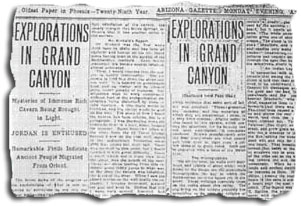 Images added. Begin quote"
Images added. Begin quote"
ARIZONA GAZETTE, MONDAY EVENING, APRIL 5, 1909
EXPLORATIONS IN GRAND CANYON
-------------------
Mysteries of Immense Rich Cavern Being Brought to Light
-------------------
JORDAN IS ENTHUSED
-------------------
Remarkable Finds Indicate Ancient People Migrated From Orient
The latest news of the progress of the explorations of what is now regarded by scientists as not only the oldest archaeological discovery in the United States, but one of the most valuable in the world, which was mentioned some time ago in the Gazette, was brought to the city yesterday by G.E. Kinkaid, the explorer who found the great underground citadel of the Grand Canyon during a trip from Green River, Wyoming, down the Colorado in a wooden boat, to Yuma, several months ago.
According to the story yesterday to the Gazette by Mr. Kinkaid, the archaeologist of the Smithsonian Institute, which is financing the explorations, have made discoveries which almost conclusively prove that the race which inhabited this mysterious cavern, hewn in solid rock by human hands, was of Oriental origin or possibly from Egypt tracing back to Ramses. If their theories are borne out of the translation of the tablets engraved with hieroglyphics, the mystery of the prehistoric peoples of North America, their ancient arts, who they were and whence they came, will be solved. Egypt and the Nile and Arizona and the Colorado will be linked by a historical chain running back to ages which staggers the wildest fancy of the fictionist.
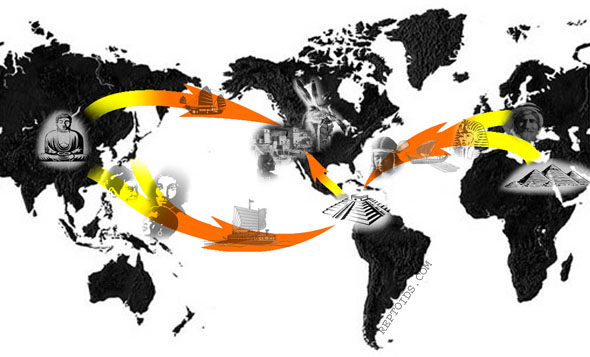
A Thorough Investigation
Under the direction of professor S.A. Jordan, the Smithsonian Institute is now prosecuting the most thorough explorations, which will be continued until the last link in the chain has been forged. Nearly a mile underground, about 1480 feet below the surface, the long main passage has been delved into, to find another mammoth chamber from which radiates scores of passageways, like the spokes of a wheel. Several hundred rooms have been discovered, reached by passageways running from the main passage, one of them having been explored for 854 feet and another 634 feet.
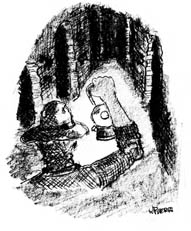 The recent finds include articles which have never been known as native to this country and doubtless they had their origin in the Orient. War weapons, copper instruments sharp edged and hard as steel, indicate the high state of civilization reached by these strange people. So interested have the scientists become that preparations are being made to equip the camp for extensive studies and the force will be increased to thirty or forty persons. Before going further into the cavern, better facilities for lighting have to be installed, for the darkness is dense and impenetrable for the average flash light. In order to avoid being lost, wires are being strung from the entrance to all passageways leading directly to large chambers. How far this cavern extends no one can guess, but it is now the belief of many that what has already been explored is merely the "Barracks", to use an American term, for the soldiers, and that far into the underworld will be found the main communal dwellings of the families and possibly other shrines. The perfect ventilation of the cavern, the steady drought that blows through, indicates that it has another outlet to the surface.
The recent finds include articles which have never been known as native to this country and doubtless they had their origin in the Orient. War weapons, copper instruments sharp edged and hard as steel, indicate the high state of civilization reached by these strange people. So interested have the scientists become that preparations are being made to equip the camp for extensive studies and the force will be increased to thirty or forty persons. Before going further into the cavern, better facilities for lighting have to be installed, for the darkness is dense and impenetrable for the average flash light. In order to avoid being lost, wires are being strung from the entrance to all passageways leading directly to large chambers. How far this cavern extends no one can guess, but it is now the belief of many that what has already been explored is merely the "Barracks", to use an American term, for the soldiers, and that far into the underworld will be found the main communal dwellings of the families and possibly other shrines. The perfect ventilation of the cavern, the steady drought that blows through, indicates that it has another outlet to the surface.
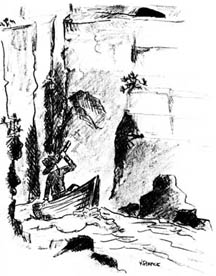 Mr. Kinkaids Report
Mr. Kinkaids Report
Mr. Kinkaid was the first white child born in Idaho and has been an explorer and hunter all his life. Thirty years having been in the service of the Smithsonian Institute. Even briefly recounted, his history sounds fabulous, almost grotesque.
"First, I would impress that the cavern is almost inaccessible. The entrance is almost 1486 feet down a shear canyon wall. It is located on government land and no visitor will be allowed there under penalty of trespass. The scientists wish to work unmolested, without fear of the archaeological discoveries being disturbed by curio or relic hunters. A trip there would be fruitless and the visitor would be sent on his way.
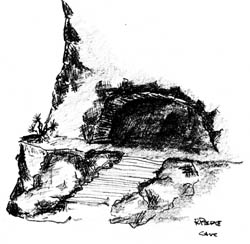 The story of how I found the cavern has already been recounted, but in a paragraph: I was journeying down the Colorado river in a boat, alone, looking for mineral. Some forty two miles up the river from El Tovar Crystal canyon, I saw on the east wall, stains in the sedimentary formation about 2000 feet above the river bed. There was no trail to this point, but I finally reached it with great difficulty. Above a shelf, which hid it from view of the river, was the mouth of the cave. There are steps leading from this entrance some thirty yards from what was at the time the cavern was inhabited, the level of the river. When I saw the chisel marks on the wall inside the entrance, I became interested, secured my gun and went in. During that trip I went back several hundred feet along the main passage, till I came to the main crypt in which I discovered the mummies. One of these I stood up and photographed by flashlight. I gathered a number of relics, which I carried down the Colorado to Yuma, from whence I shipped them to Washington with details of the discovery. Following this, the explorations were undertaken".
The story of how I found the cavern has already been recounted, but in a paragraph: I was journeying down the Colorado river in a boat, alone, looking for mineral. Some forty two miles up the river from El Tovar Crystal canyon, I saw on the east wall, stains in the sedimentary formation about 2000 feet above the river bed. There was no trail to this point, but I finally reached it with great difficulty. Above a shelf, which hid it from view of the river, was the mouth of the cave. There are steps leading from this entrance some thirty yards from what was at the time the cavern was inhabited, the level of the river. When I saw the chisel marks on the wall inside the entrance, I became interested, secured my gun and went in. During that trip I went back several hundred feet along the main passage, till I came to the main crypt in which I discovered the mummies. One of these I stood up and photographed by flashlight. I gathered a number of relics, which I carried down the Colorado to Yuma, from whence I shipped them to Washington with details of the discovery. Following this, the explorations were undertaken".
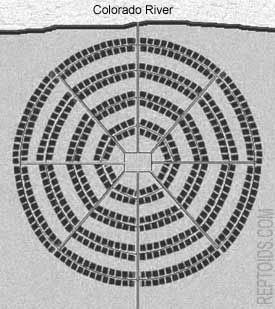
The Passages
"The main passageway is about 12 feet wide, narrowing to 9 feet toward the farther end. About 57 feet from the entrance, the first passages branch off to the right and left, along which, on both sides, are a number of rooms about the size of ordinary living rooms of today, though some are 30 to 40 feet square.
These are entered by oval shaped doors and are ventilated by round air spaces through the walls into the passages. The walls are about 3 feet 6 inches in thickness. The passages are chiseled or hewn as straight as could be laid out by any engineer. The ceilings of many of the rooms converge to a center. The side passages near the entrance run at a sharp angle from the main hall, but toward the rear they gradually reach a right angle in direction".
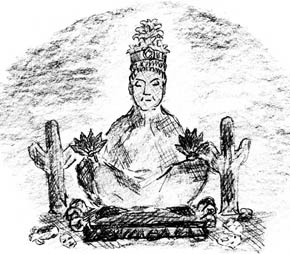
The Shrine
"Over a hundred feet from the entrance is a cross-hall, several hundred feet long, in which was found the idol, or image, of the peoples god, sitting cross-legged, with a Lotus flower or Lily in each hand. The cast of the face is Oriental, and the carving shows a skillful hand, and the entire is remarkably well preserved, as is everything in this cavern. The idol most resembles Buddha, though the scientists are not certain as to what religious worship it represents. Taking into consideration everything found thus far, it is possible that the worship most resembles the ancient people of Thibet. Surrounding this idol are smaller images, some beautiful in form, other crooked necked and distorted shapes, symbolical, probably, of good and evil. There are two large cacti with protruding arms, one on each side of the dais on which the god squats. All this is carved out of hard rock resembling marble.
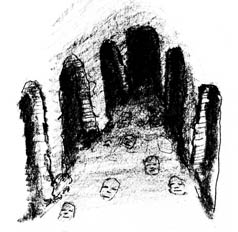 In the opposite corner of this cross-hall were found tools of all descriptions, made of copper. This people undoubtedly knew the lost art of hardening this metal, which has been sought by chemists for centuries without result. On a bench running around the workroom was some charcoal and other material probably used in the process. There is also slag and stuff similar to matte, showing that these ancient peoples smelted ores, but so far, no trace of where of how this was done has been discovered, nor the origin of the ore. Among other finds are vases or urns and cups of copper and gold made very artistic in design. The pottery work includes enameled ware and glazed vessels.
In the opposite corner of this cross-hall were found tools of all descriptions, made of copper. This people undoubtedly knew the lost art of hardening this metal, which has been sought by chemists for centuries without result. On a bench running around the workroom was some charcoal and other material probably used in the process. There is also slag and stuff similar to matte, showing that these ancient peoples smelted ores, but so far, no trace of where of how this was done has been discovered, nor the origin of the ore. Among other finds are vases or urns and cups of copper and gold made very artistic in design. The pottery work includes enameled ware and glazed vessels.
Another passageway leads to granaries such as are found in the Oriental temples. They contain seeds of various kinds. One very large storehouse has not been entered, as it is twelve feet high and can be reached only from above. Two copper hooks extend on the edge, (continued on page 7) which indicates that some sort of ladder was attached. These granaries are rounded and the materials of which they are constructed, I think, is a very hard cement. A grey metal is also found in this cavern which puzzles the scientists, for it's identity has not been established. It resembles platinum. Strewn promiscuously over the floor everywhere are what people call "Cats eyes" or "Tiger eyes", a yellow stone of no great value. Each one is engraved with a head of a Malay type."
 The Hieroglyphics
The Hieroglyphics
"On all the urns, on the walls over the doorways and tablets of stone which were found by the image are mysterious hieroglyphics, the key to which the Smithsonian Institution hopes yet to discover. These writings resemble those found on the rocks about this valley. The engraving on the tablets probably has something to do with the religion of the people, Similar hieroglyphics have been found in the peninsula of Yucatan, but these are not found in the Orient. Some believe that these cave dwellers built the old canals in the Salt River valley. Among the pictorial writings only two animals are found. One is of prehistoric type".
The Crypt
"The tomb or crypt in which the mummies are found is one of the largest of the chambers, the walls slanting back at an angle of about 35 degrees. One these are tiers of mummies, each one occupying a separate hewn shelf. At the head of each is a small bench on which is found copper cups and pieces of broken swords. Some of the mummies are covered with clay and all are wrapped in a bark fabric. The urns or cups on the lower tiers are crude, while as the higher shelves are reached, the urns are finer in design showing a interstage of civilization. It is worthy of note that all the mummies examined so far have proved to be male, no children or females being buried here. This leads to the belief that this interior section was the warriors barracks.
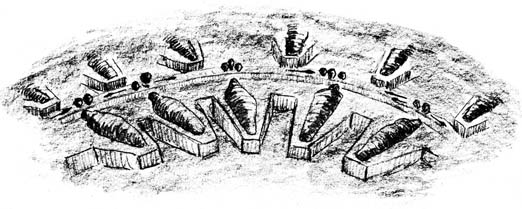
Among the discoveries no bones of animals have been found, no skins, no clothing nor bedding. Many of the rooms are bare but for the water vessels. One room, about 400 by 700 feet, was probably the main dining hall for cooking utensils are found here. What these people lived on is a problem, though it is presumed that they came south for the winter and farmed in the valleys, going back north in the summer. Upwards of 50,000 people could have lived in the cavern comfortably.
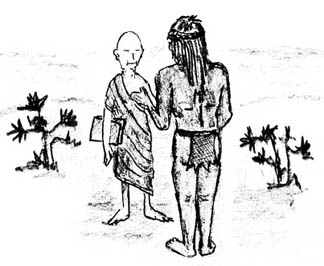 One theory is that the present Indian tribe found in Arizona are descendants of the serfs or slaves of the people which inhabited the cave. Undoubtedly a good many thousands of years before the Christian era a people lived here which reached a high state of civilization. The chronology of human history is full of gaps. Prof. Jordan is much enthused over the discoveries and believes that the find will prove of incalculable value in archaeological work.
One theory is that the present Indian tribe found in Arizona are descendants of the serfs or slaves of the people which inhabited the cave. Undoubtedly a good many thousands of years before the Christian era a people lived here which reached a high state of civilization. The chronology of human history is full of gaps. Prof. Jordan is much enthused over the discoveries and believes that the find will prove of incalculable value in archaeological work.
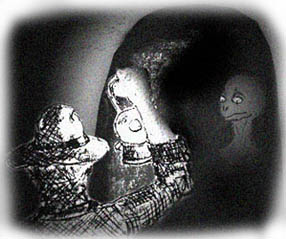
One thing I have spoken of may be of interest. There is one chamber the passageways to which is not ventilated and when we approach it a deadly, snaky smell struck us. Our lights would not penetrate the gloom and until stronger ones are available, we will not know what the chamber contains. Some say snakes, but others boo-hoo this idea and think that it may contain a deadly gas or chemicals used by the ancients. No sounds are heard, but it smells snaky just the same.
The whole underground institution gives one of shaky nerves the creeps. The gloom is like a weight on ones shoulders and our flashlights and candles only make the darkness blacker.
Imagination can revel in conjectures and ungodly day-dreams back through the ages that have elapsed till the mind reels dizzily in space".
An Indian Legend
In connection with this story, it is notable that among the Hopis the tradition is told that their ancestors once lived in an underworld in the Grand Canyon till dissension arose between the good and the bad, the people of one heart, the people of two hearts. (Manchoto) who was their chief, counselled them to leave the underworld, but there was no way out. The chief then caused a tree to grow up and pierce the roof of the underworld and then the people of one heart climbed out. They tarried by Palsiaval (Red River), which is the Colorado, and grew grain and corn. They sent out a message to the temple of the sun, asking the blessing of peace, good will and rain for the people of one heart. That messenger never returned but, today at the Hopi village, at sundown can be seen the old men of the tribe out on the housetops gazing towards the sun, looking for the messenger. When he returns, their land and ancient dwelling place will be restored to them. That is the tradition.
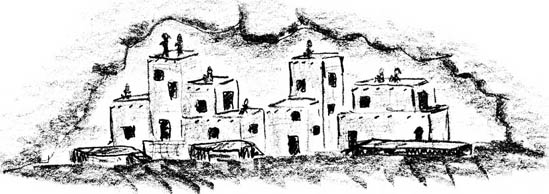
Among the engravings of animals in the cave is seen a image of a heart over the spot where it is located. The legend was learned by W.E. Rollins, the artist, during a year spent with the Hopi Indians. There are two theories of the origin of the Egyptians. One is that they came from Asia: another is that the racial cradle was in the upper Nile region. Heeren, an Egyptologist, believed in the Indian origin of the Egyptians. The discoveries in the Grand Canyon may throw further light on human evolution and prehistoric ages."
There is one chamber of the passageway to which is not ventilated, and when we approached it a deadly, snaky smell struck us. Our light would not penetrate the gloom, and until stronger ones are available we will not know what the chamber contains. Some say snakes, but other boo-hoo this idea and think it may contain a deadly gas or chemicals used by the ancients. No sounds are heard, but it smells snaky just the same. The whole underground installation gives one of shaky nerves the creeps. The gloom is like a weight on one's shoulders, and our flashlights and candles only make the darkness blacker. Imagination can revel in conjectures and ungodly daydreams back through the ages that have elapsed till the mind reels dizzily in space.”
http://www.philipcoppens.com/egyptiancanyon.html

Grand Canyon Temple of Isis

The Mummies of the Grand Canyon | O

GRAND CANYON
Evidence of an Ancient Civilization - hidden from the mainstream public eye.
Cave Drawings

Below is a drawing from the original 1908 expedition. The mummies seem to be displayed differently.
Though this discovery says "oriental" orgins, I value your expertise in regards to the weapons.
Below is the 1909 article which has been REMOVED from the archives and the Smithsonian has covered this up. The area has been bought out by the US govt and it's forbidden for us to go there.
There is also speculation that an ancient craft was discovered. If that is true, no wonder it's been covered up. We're not supposed to know about the real history.
I believe the Aryans (NAZIS/ISRAELIS) who currently rule over us seek to suppress knowledge.
_____________________________
http://www.bibliotecapleyades.net/esp_orionzone_9.htm
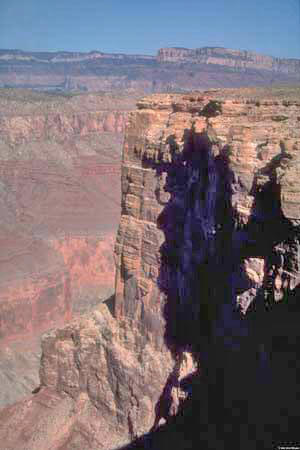
Isis Temple is mathematically connected to:
* slope angle of the Great Pyramid
* grid point value of the Great Pyramid
* derived height of Great Pyramid with capstone included
* decimal harmonic of the East longitude of the Sphinx at Giza
* decimal harmonic of the West longitude of the Chephren Pyramid at Giza
* decimal harmonic of the tangent of arc-distance from Earth's equator to either pole
* radius of Moon
* ratio of radius of Stonehenge's Sarsen Circle and Radian (deg)
* decimal harmonic of generic area of a circle
* grid point value of the star Sirius, circa 2000 a.d.
* grid point value of the star Regulus, circa 2000 a.d.
* East latitude, in arc-min., of the "Face" at Cydonia on Mars
ANCIENT EGYPTIAN TREASURES IN THE GRAND CANYON
Views: 137
© 2025 Created by Besimi.
Powered by
![]()

